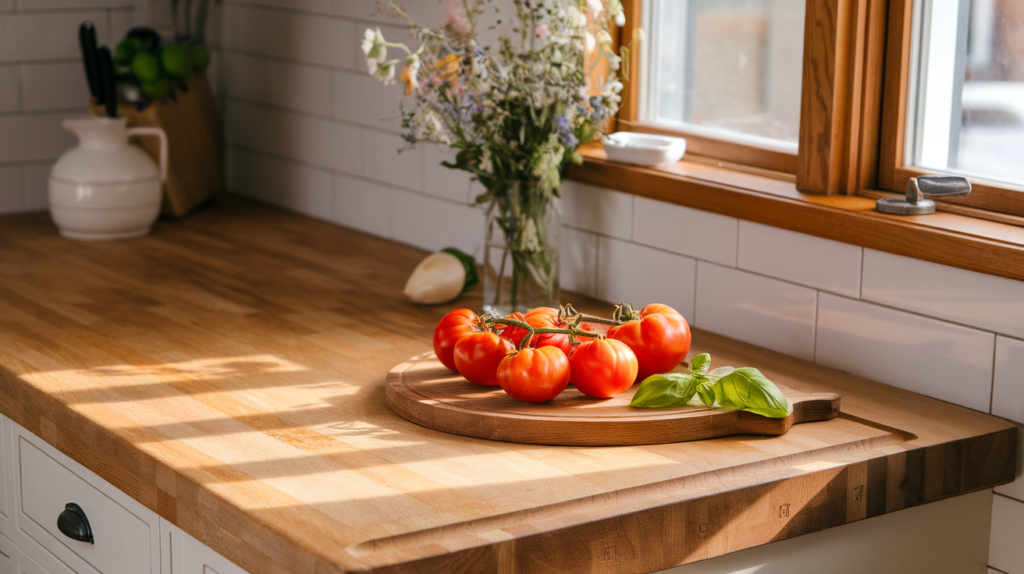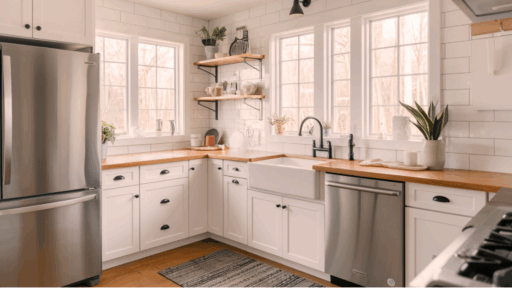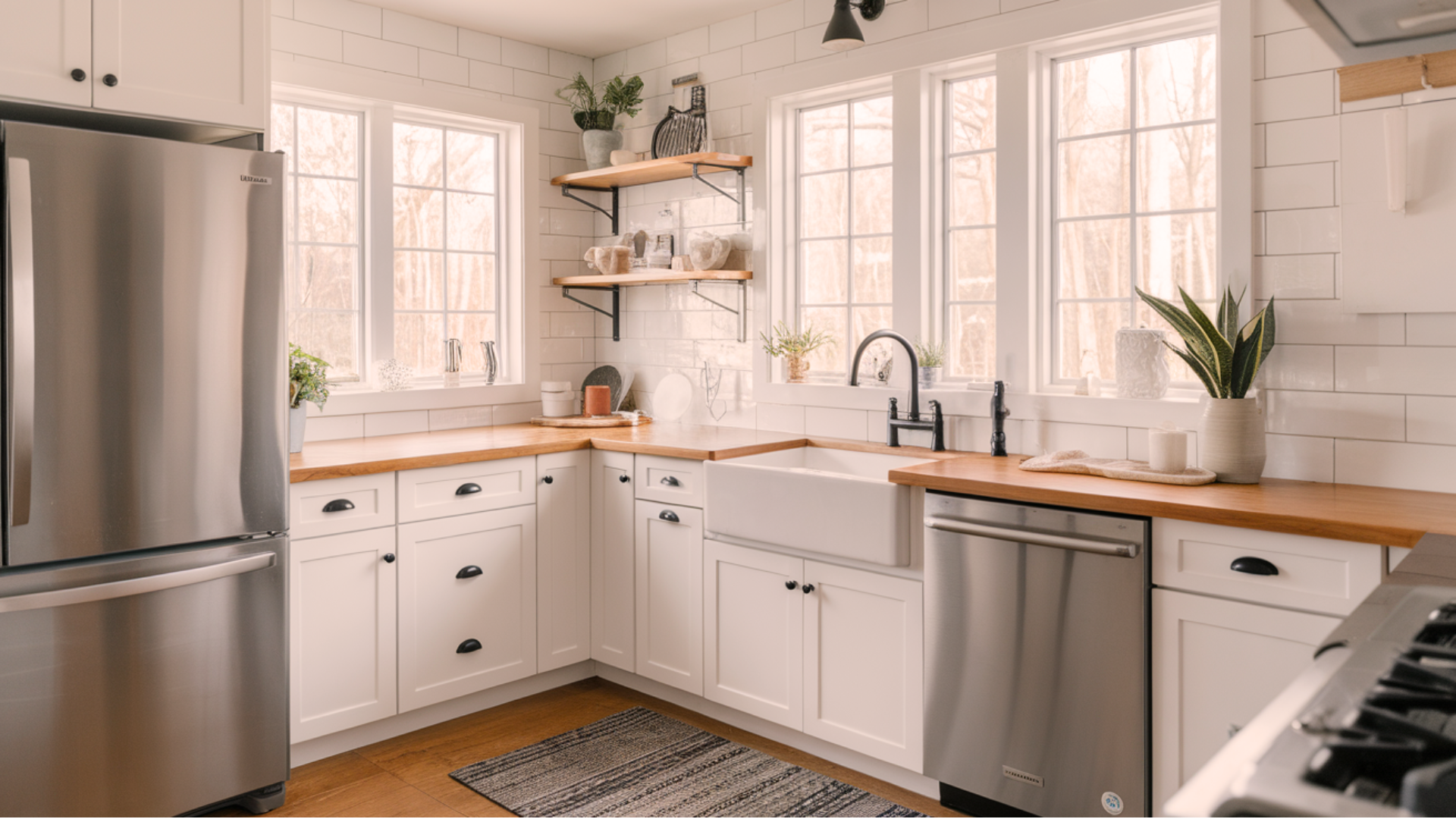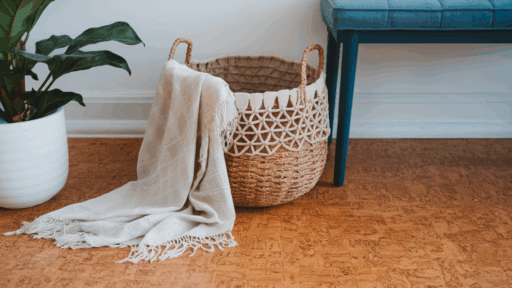I remember staining my first slab of butcher block and wondering if I’d made a mistake. Wood counters look gorgeous, but are they practical? Are these warm, wooden surfaces really worth the investment?
If you’re stuck between choosing kitchen countertops and feeling overwhelmed, you’re in the right place. My guide will break down everything you need to know about butcher block counters:
- Maintenance secrets
- Cost considerations
- Pros and cons
I’ve spent years working with different kitchen surfaces, and I’ll give you an honest, no-nonsense look at whether butcher block truly fits your home.
I’ll share practical insights that will help you make a smart decision. My goal? To solve your countertop dilemma and help you choose confidently.
Trust me to provide clear, straightforward advice that cuts through the noise.
What Are Butcher Block Countertops?
Butcher block countertops are made from thick strips of wood that are glued together to form a solid, sturdy surface.
They’re called “butcher block” because they were first used in butcher shops as cutting surfaces. These countertops bring a warm, natural look to kitchens and work well in both modern and farmhouse-style homes.
You can find them in different types of wood like maple, oak, walnut, or birch.
One thing I like about butcher block is that you can sand and refinish it if it gets scratched, which helps it last a long time.
Just keep in mind that wood is more sensitive to water, so it needs regular sealing and care.
If you want a countertop that feels cozy, timeless, and a little rustic, butcher block is a great option to consider for your kitchen.
Butcher Block Countertop Pros

Learn the compelling reasons why butcher block countertops might be the hidden gem your kitchen needs.
From unique character to practical benefits, we’ll learn the strengths that make these wooden surfaces stand out from the crowd.
1. Natural Beauty that Tells a Story
Wood isn’t just a surface; it’s a living, breathing canvas. Each butcher block countertop is like a fingerprint: totally unique.
When you run your hand across the grain, you’ll feel the character, the subtle waves and whorls that make your kitchen truly yours.
2. Scratch? No Problem
Imagine a countertop that forgives your mistakes. Drop a pan, scratch the surface? No panic attack needed.
Unlike stone or granite, wooden counters are a repair-friendly surface. A quick sanding can make scratches disappear like magic. It’s like having a self-healing superhero in your kitchen.
3. Knife-Friendly Zone
Your expensive knife collection will thank you. End-grain butcher block is basically a knife’s best friend. It’s softer than cutting directly on stone, which means less blade dulling.
Picture this: you’re chopping vegetables, and your knife glides smoothly without that horrible scraping sound.
4. Budget-Wise Brilliance
Let’s talk money. Drumroll, please. Butcher block often costs less than fancy stone countertops.
At the entry level, you’re getting warmth, function, and style without emptying your wallet. Who doesn’t love a smart financial choice that looks beautiful?
Butcher Block Countertop Cons
Understand these limitations to make an informed decision that will match your lifestyle and kitchen expectations.
1. The Vulnerability Factor
Wood isn’t invincible. Think of your countertop like a leather jacket – beautiful, but needs careful handling. Edge-grain surfaces especially show every little bump and bruise.
Drop a cast-iron pan? That’s going to leave a mark. Your countertop will collect memories faster than you might want.
2. Maintenance: Not for the Lazy
Regular oiling isn’t a suggestion – it’s a requirement. Imagine your countertop is a thirsty plant that needs consistent care. Without proper sealing, water becomes its worst enemy.
You’ll need to oil the surface every few weeks to keep it water-resistant. For busy homeowners, this can feel like another chore on an endless list.
3. Bacterial Battlefield
Wooden surfaces can trap bacteria if not cleaned meticulously. Unlike cold, hard stone, wood has tiny pores where microbes love to hide.
Your cutting board technique matters big time. Proper cleaning and immediate drying become your primary defense against unwanted kitchen guests.
4. Temperature and Moisture Drama
Hot pans are wood’s kryptonite. Standing water is like a slow poison for your beautiful countertop.
One forgotten wet towel or a blazing-hot pot can cause warping or permanent staining. It’s like walking a tightrope between beautiful and damaged.
Reasons to Consider Butcher Block Countertops

Wondering if butcher block is your kitchen’s perfect match? Look into the key reasons why these wooden wonders might be exactly what your space needs.
It Creates a Warm, Welcoming Feel
Butcher block countertops instantly make a kitchen feel cozy and inviting. Unlike stone or metal, wood has a natural softness that brings warmth to your space.
It works beautifully in all kinds of styles – farmhouse, rustic, coastal, modern, or even Scandinavian. If you want your kitchen to feel like the heart of your home, wood is a great way to get that look and feeling.
The natural grain and texture add charm and visual interest without trying too hard.
Great for DIY Lovers
If you’re someone who enjoys rolling up your sleeves and doing things yourself, butcher block is a dream. It’s one of the easiest countertop materials to work with, and it gives you the freedom to maintain it yourself.
Need to smooth out a scratch or watermark? Just sand it down and apply a little food-grade mineral oil. That’s it. Many people find this upkeep relaxing and rewarding.
A Cook-Friendly Surface
Butcher block isn’t just nice to look at – it’s also great for cooking. The surface is softer and more forgiving than granite or quartz, which means it’s easier on your knives.
That’s why professional chefs often use wooden prep tables. While you’ll still want to use cutting boards to avoid deep cuts or staining, butcher block is ideal for people who cook a lot.
Budget-Friendly Style
Kitchen renovations can be expensive, and countertops are one of the biggest costs. Butcher block gives you a beautiful, high-end look without the high-end price tag.
It’s more affordable than materials like marble or quartz and still delivers big on style. If you’re remodeling your whole kitchen or just want to replace old counters, butcher block is a smart, budget-conscious choice.
Butcher Block vs. Other Countertop Materials
Learn the real differences in durability, cost, maintenance, and aesthetic appeal to help you make the smartest kitchen surface choice.
| Countertop Type | Butcher Block | Other Material | Key Differences |
|---|---|---|---|
| Granite/Quartz | Warm, repairable wood | Hard, tough stone | • Granite wins on scratch resistance • Wood brings natural warmth • Stone is virtually maintenance-free |
| Laminate | Genuine wood with character | Synthetic wood look | • Butcher block is real wood • Wood brings genuine texture • Synthetic option mimics wood cheaply |
| Stainless Steel/Concrete | Characterful wooden surface | Industrial, cold material | • Butcher block feels homey • Wood adds warmth to the kitchen • Metal/concrete is more expensive to install |
Pro Tip: Your choice depends on lifestyle and kitchen personality. Are you a chef who loves character? Butcher block might be your soulmate. Want zero maintenance? Stone could be your match.
Can You Use Butcher Block Countertops as a Cutting Board?
Picture this: You’re standing in the kitchen, knife in hand, wondering if your beautiful butcher block can double as a cutting surface. The short answer?
It’s complicated. Edge-grain countertops are like that friend who’s game but not totally prepared; they’ll let you chop, but they’ll show every single mark.
End-grain? Now we’re talking. It’s the superhero of wood surfaces, self-healing and knife-friendly.
Just because you can doesn’t mean you should. Treat your countertop like a treasured relationship. Constant direct chopping is like death by a thousand cuts.
Your best move? Keep a dedicated cutting board nearby. Use it for heavy chopping, raw meats, and those marathon meal prep sessions.
Your butcher block will thank you by staying gorgeous and lasting years longer.
Butcher Block Countertop Maintenance and Care

Learn the secrets of daily care, monthly conditioning, and avoiding common pitfalls that can damage your beautiful surface.
- Daily cleaning is like a quick morning shower for your countertop. Use a soft cloth, mild soap, and warm water. Wipe gently and dry immediately.
- Monthly conditioning keeps the wood from drying out. Apply food-grade mineral oil with a soft cloth, rubbing it in along the grain. Let it sit for about 20 minutes, then wipe away the extra.
- Sanding is perfect when the surface looks scratched or dull. Use fine-grit sandpaper, always moving with the grain. After sanding, wipe away the dust and reapply oil. It instantly refreshes the look.
- Avoidcommon hazards: standing water, hot pans, bleach, and harsh chemicals. These can stain, scorch, or damage your butcher block beyond easy repair.
Conclusion
Let’s cut to the chase. Butcher block is like that high-maintenance friend who’s totally worth the effort. Pros? Warmth, character, and repairability. Cons? Regular care and vulnerability to damage.
Who’s the perfect match? Kitchen lovers who don’t mind a little TLC. If you’re a cooking enthusiast with a farmhouse dream and some DIY spirit, this surface will make your heart sing.
Not your style? Stone or granite might be your soulmate. Worried about perfection? Don’t be.
Every scratch tells a story. Every oil treatment is a moment of connection with your space. Your countertop will grow and change with you.
If you’re ready to roll up your sleeves, butcher block might just be your new kitchen BFF.
Take your time, enjoy every step, and make your space truly your own.








